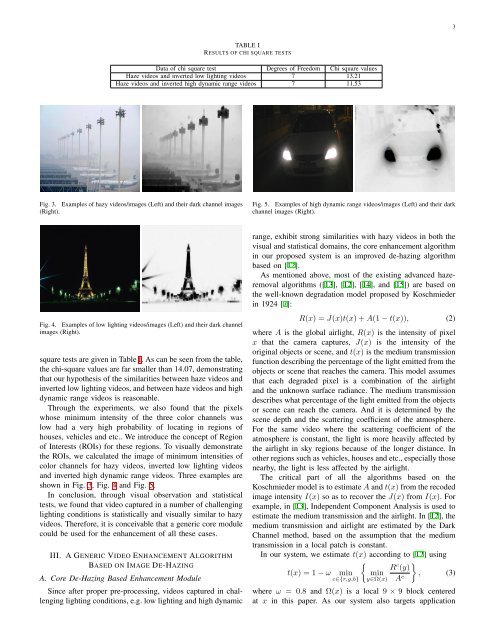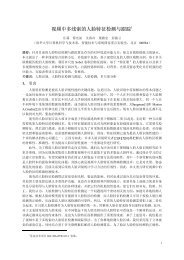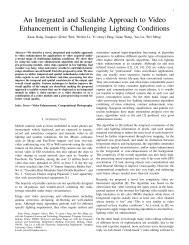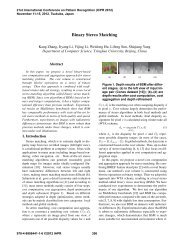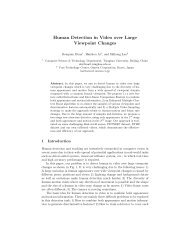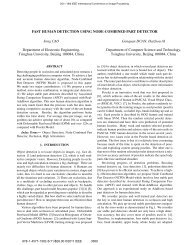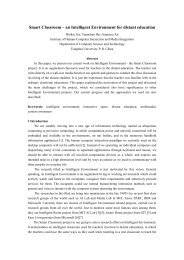An Efficient and Integrated Algorithm for Video Enhancement in ...
An Efficient and Integrated Algorithm for Video Enhancement in ...
An Efficient and Integrated Algorithm for Video Enhancement in ...
Create successful ePaper yourself
Turn your PDF publications into a flip-book with our unique Google optimized e-Paper software.
3<br />
TABLE I<br />
RESULTS OF CHI SQUARE TESTS<br />
Data of chi square test Degrees of Freedom Chi square values<br />
Haze videos <strong>and</strong> <strong>in</strong>verted low light<strong>in</strong>g videos 7 13.21<br />
Haze videos <strong>and</strong> <strong>in</strong>verted high dynamic range videos 7 11.53<br />
Fig. 3. Examples of hazy videos/images (Left) <strong>and</strong> their dark channel images<br />
(Right).<br />
Fig. 5. Examples of high dynamic range videos/images (Left) <strong>and</strong> their dark<br />
channel images (Right).<br />
Fig. 4. Examples of low light<strong>in</strong>g videos/images (Left) <strong>and</strong> their dark channel<br />
images (Right).<br />
square tests are given <strong>in</strong> Table I. As can be seen from the table,<br />
the chi-square values are far smaller than 14.07, demonstrat<strong>in</strong>g<br />
that our hypothesis of the similarities between haze videos <strong>and</strong><br />
<strong>in</strong>verted low light<strong>in</strong>g videos, <strong>and</strong> between haze videos <strong>and</strong> high<br />
dynamic range videos is reasonable.<br />
Through the experiments, we also found that the pixels<br />
whose m<strong>in</strong>imum <strong>in</strong>tensity of the three color channels was<br />
low had a very high probability of locat<strong>in</strong>g <strong>in</strong> regions of<br />
houses, vehicles <strong>and</strong> etc.. We <strong>in</strong>troduce the concept of Region<br />
of Interests (ROIs) <strong>for</strong> these regions. To visually demonstrate<br />
the ROIs, we calculated the image of m<strong>in</strong>imum <strong>in</strong>tensities of<br />
color channels <strong>for</strong> hazy videos, <strong>in</strong>verted low light<strong>in</strong>g videos<br />
<strong>and</strong> <strong>in</strong>verted high dynamic range videos. Three examples are<br />
shown <strong>in</strong> Fig. 3, Fig. 4 <strong>and</strong> Fig. 5.<br />
In conclusion, through visual observation <strong>and</strong> statistical<br />
tests, we found that video captured <strong>in</strong> a number of challeng<strong>in</strong>g<br />
light<strong>in</strong>g conditions is statistically <strong>and</strong> visually similar to hazy<br />
videos. There<strong>for</strong>e, it is conceivable that a generic core module<br />
could be used <strong>for</strong> the enhancement of all these cases.<br />
III. A GENERIC VIDEO ENHANCEMENT ALGORITHM<br />
BASED ON IMAGE DE-HAZING<br />
A. Core De-Haz<strong>in</strong>g Based <strong>Enhancement</strong> Module<br />
S<strong>in</strong>ce after proper pre-process<strong>in</strong>g, videos captured <strong>in</strong> challeng<strong>in</strong>g<br />
light<strong>in</strong>g conditions, e.g. low light<strong>in</strong>g <strong>and</strong> high dynamic<br />
range, exhibit strong similarities with hazy videos <strong>in</strong> both the<br />
visual <strong>and</strong> statistical doma<strong>in</strong>s, the core enhancement algorithm<br />
<strong>in</strong> our proposed system is an improved de-haz<strong>in</strong>g algorithm<br />
based on [12].<br />
As mentioned above, most of the exist<strong>in</strong>g advanced hazeremoval<br />
algorithms ([13], [12], [14], <strong>and</strong> [15]) are based on<br />
the well-known degradation model proposed by Koschmieder<br />
<strong>in</strong> 1924 [7]:<br />
R(x) = J(x)t(x) + A(1 − t(x)), (2)<br />
where A is the global airlight, R(x) is the <strong>in</strong>tensity of pixel<br />
x that the camera captures, J(x) is the <strong>in</strong>tensity of the<br />
orig<strong>in</strong>al objects or scene, <strong>and</strong> t(x) is the medium transmission<br />
function describ<strong>in</strong>g the percentage of the light emitted from the<br />
objects or scene that reaches the camera. This model assumes<br />
that each degraded pixel is a comb<strong>in</strong>ation of the airlight<br />
<strong>and</strong> the unknown surface radiance. The medium transmission<br />
describes what percentage of the light emitted from the objects<br />
or scene can reach the camera. <strong>An</strong>d it is determ<strong>in</strong>ed by the<br />
scene depth <strong>and</strong> the scatter<strong>in</strong>g coefficient of the atmosphere.<br />
For the same video where the scatter<strong>in</strong>g coefficient of the<br />
atmosphere is constant, the light is more heavily affected by<br />
the airlight <strong>in</strong> sky regions because of the longer distance. In<br />
other regions such as vehicles, houses <strong>and</strong> etc., especially those<br />
nearby, the light is less affected by the airlight.<br />
The critical part of all the algorithms based on the<br />
Koschmieder model is to estimate A <strong>and</strong> t(x) from the recoded<br />
image <strong>in</strong>tensity I(x) so as to recover the J(x) from I(x). For<br />
example, <strong>in</strong> [13], Independent Component <strong>An</strong>alysis is used to<br />
estimate the medium transmission <strong>and</strong> the airlight. In [12], the<br />
medium transmission <strong>and</strong> airlight are estimated by the Dark<br />
Channel method, based on the assumption that the medium<br />
transmission <strong>in</strong> a local patch is constant.<br />
In our system, we estimate t(x) accord<strong>in</strong>g to [12] us<strong>in</strong>g<br />
t(x) = 1 − ω<br />
m<strong>in</strong><br />
c∈{r,g,b}<br />
{<br />
m<strong>in</strong><br />
y∈Ω(x)<br />
R c }<br />
(y)<br />
A c , (3)<br />
where ω = 0.8 <strong>and</strong> Ω(x) is a local 9 × 9 block centered<br />
at x <strong>in</strong> this paper. As our system also targets application


